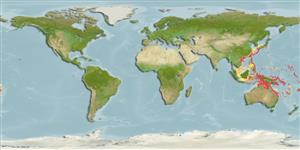>
Gobiiformes (Gobies) >
Gobiidae (Gobies) > Gobiinae
Etymology: Trimma: Greek, trimma, -atos = something crushed (Ref. 45335); nomurai: Named for Mr. Tomoyuki Nomura, who provided the holotype.
Eponymy: Tomoyuki Nomura is a volunteer in the Fish Division of the Kanagawa Prefectural Museum of Natural History, Japan. [...] (Ref. 128868), visit book page.
Environment: milieu / climate zone / depth range / distribution range
Ecología
marino asociado a arrecife; rango de profundidad 35 - 70 m (Ref. 75857). Subtropical
Distribución
Países | Áreas FAO | Ecosistemas | Ocurrencias, apariciones | Point map | Introducciones | Faunafri
Western Pacific: Japan, Indonesia and New Caledonia.
Tamaño / Peso / Age
Maturity: Lm ? range ? - ? cm
Max length : 1.9 cm SL macho / no sexado; (Ref. 75857); 1.6 cm SL (female)
Short description
Claves de identificación | Morfología | Morfometría
Espinas dorsales (total) : 7; Radios blandos dorsales (total) : 8 - 9; Espinas anales: 1; Radios blandos anales: 8 - 9; Vértebra: 26. This species is distinguished by the following set of characters: predorsal scales 5-6 ; second spine of first dorsal fin elongate and filamentous; middle 9-15 (of 19) rays of pectoral fin branched; fifth pelvic-fin ray branched, 72-90% of fourth ray in length; height of connecting membrane between innermost pelvic-fin rays 28% of length of fifth ray; interorbital and postorbital trenches deep; longitudinal scales 22-23; opercular scales absent; ground color of head and body pale lilac, 3 vivid yellow longitudinal stripes on body and vertical fins, when fresh a large rounded dark brown blotch posterodorsally to base of pectoral fin (Ref. 75857).
Inhabits rubble bottoms (Ref. 90102).
Life cycle and mating behavior
Madurez | Reproducción | Puesta | Huevos | Fecundidad | Larva
Suzuki, T. and H. Senou, 2007. Two new species of the gobiid fish genus Trimma (Perciformes: Gobioidei) from Southern Japan. Bull. Natl. Mus. Nat. Sci. Ser. A. Suppl. 1:175-184. (Ref. 75857)
IUCN Red List Status (Ref. 130435: Version 2024-1)
Threat to humans
Harmless
Human uses
Pesquerías: sin interés
Herramientas
Special reports
Download XML
Fuentes de Internet
Estimates based on models
Preferred temperature (Ref.
123201): 22.7 - 28.3, mean 27.2 °C (based on 89 cells).
Phylogenetic diversity index (Ref.
82804): PD
50 = 0.5000 [Uniqueness, from 0.5 = low to 2.0 = high].
Bayesian length-weight: a=0.01023 (0.00477 - 0.02194), b=3.01 (2.83 - 3.19), in cm total length, based on LWR estimates for this (Sub)family-body shape (Ref.
93245).
Resiliencia (Ref.
120179): Alto, población duplicada en un tiempo mínimo inferior a 15 meses (Preliminary K or Fecundity.).
Fishing Vulnerability (Ref.
59153): Low vulnerability (10 of 100).
